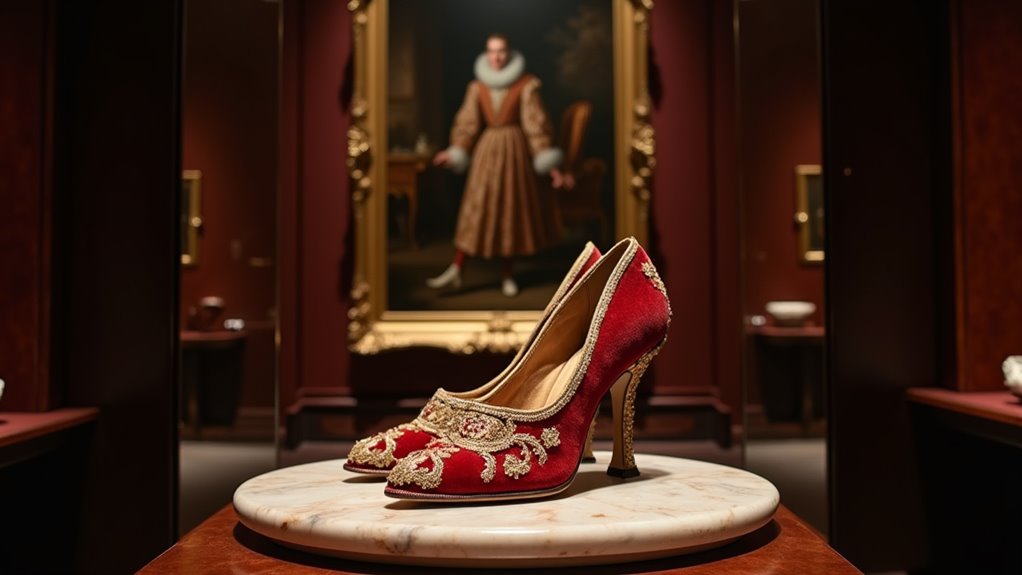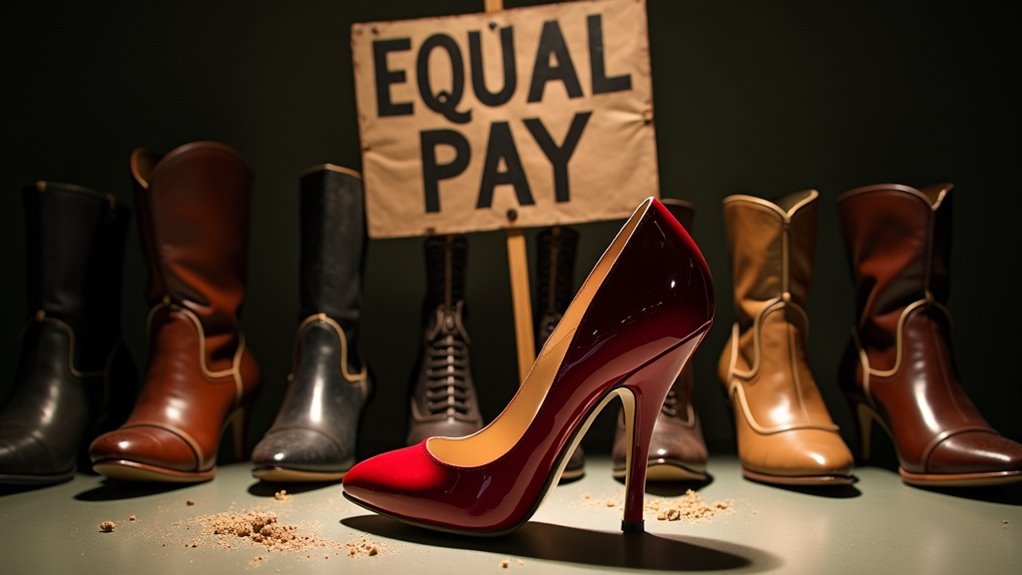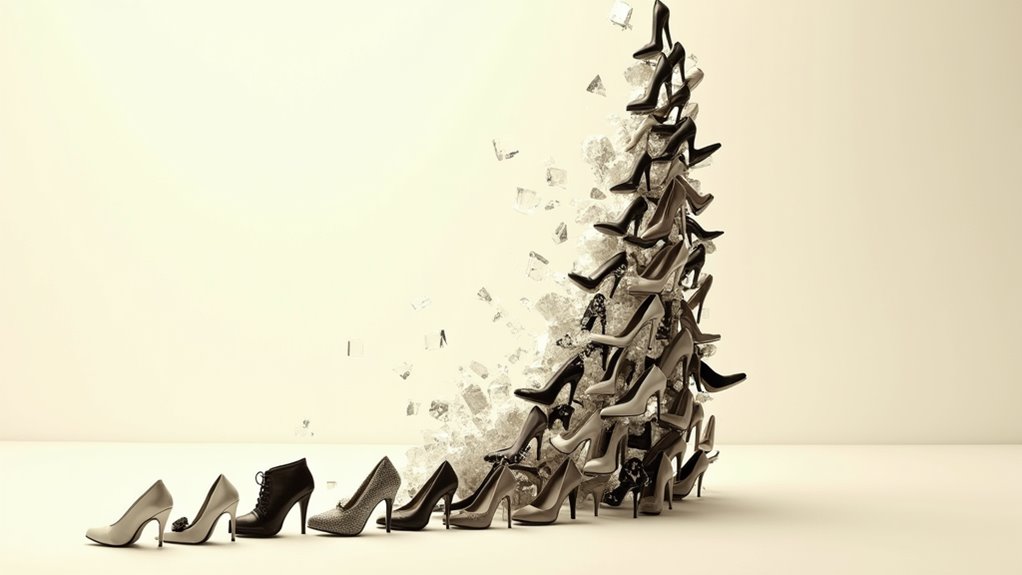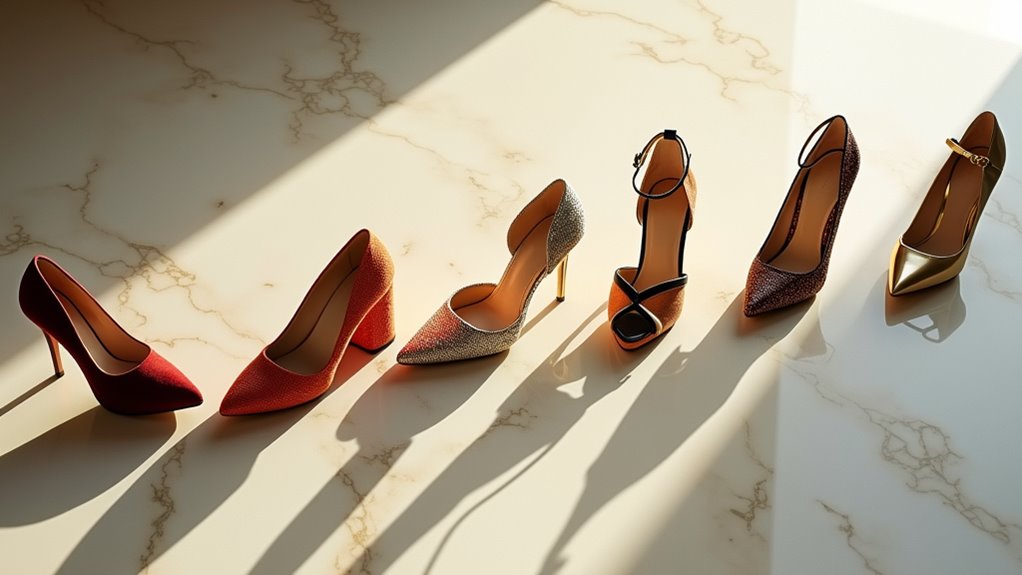There may be products. Products are independently selected by our editors. We may earn an affiliate commission from the links with no charge to you, example: as Amazon Affiliate.
We can trace high heels’ fascinating journey from 10th-century Persian cavalry boots to modern symbols of feminine power. Initially designed for male riders to maintain stability in stirrups, these practical military shoes caught European aristocracy’s attention in the 16th century. King Louis XIV’s red-heeled shoes became the height of nobility, but by the 18th century, heels had transformed into distinctly feminine fashion statements. Today’s $34 billion industry reflects their evolution from masculine authority to feminine empowerment, despite known health risks. The story of high heels reveals complex intersections of gender, power, and cultural expectations throughout history’s changing landscape.
Key Takeaways
- High heels originated as masculine military footwear in 10th century Persia before evolving into symbols of feminine power and status.
- Catherine de Medici popularized heels among women in the 16th century, marking a pivotal shift in gender associations.
- Louis XIV’s red-heeled shoes transformed high heels into elite status symbols before they became predominantly feminine fashion items.
- Stilettos emerged in the mid-20th century as powerful symbols of female empowerment during women’s workplace advancement.
- Modern high heels generate $34 billion annually and remain cultural symbols of feminine authority in professional settings.
The Royal Origins of Heels

Nearly a millennium before becoming a symbol of feminine fashion, high heels emerged from the practical needs of Persian horsemen in the 10th century. What we now recognize as high-heeled shoes originated as functional cavalry equipment in the Persian Empire, designed to provide stability and leverage in stirrups during horseback riding and warfare.
The transformation of heels from military gear to courtly fashion began through diplomatic relations between Persia and European powers in the 16th century. As Shah Abbas strengthened ties with European courts, the Persian style of elevated footwear captivated Western aristocracy. We can trace the pivotal moment in heel history to King Louis XIV, who made red-heeled shoes his signature royal statement in 17th century France. His influence dramatically shifted societal norms around footwear and power. Today’s fashion enthusiasts can channel this regal heritage by incorporating vintage statement heels into their modern wardrobes.
From Horseback to High Society
We can trace high heels’ fascinating transformation from their Persian cavalry origins, where they served the practical purpose of keeping riders’ feet anchored in stirrups while shooting arrows on horseback. In European courts, particularly under Louis XIV’s influence, men’s heels evolved into intricate status symbols that literally and figuratively elevated nobles above commoners. As these elevated shoes transitioned from masculine power symbols into women’s fashion during the 17th and 18th centuries, they became powerful markers of feminine grace and social influence, completely departing from their utilitarian military roots. Modern heel designs prioritize supportive construction to enhance comfort while maintaining their elegant aesthetic appeal.
Persian Cavalry’s Practical Origins
History’s most iconic fashion statements often emerge from unexpected origins, and the high heel’s journey from battlefield to ballroom stands as a testament to this truth. When we examine the practical roots of high heels, we’re transported to 10th century Persia, where the Persian cavalry revolutionized riding shoes with an innovation that would transform fashion forever.
The original functions of these elevated shoes were remarkably practical, serving four essential purposes:
- Provided secure footing in stirrups during intense horseback riding
- Prevented slipping forward while mounting and charging
- Enhanced stability during archery and combat maneuvers
- Distinguished mounted warriors from foot soldiers
We’re fascinated to discover that these riding shoes quickly transcended their military origins, becoming a symbol of status among Persian noblemen. The practical design proved so effective that it spread throughout Persian society, with soldiers and aristocrats alike adopting the elevated heel. What began as a solution to horseback riding challenges would eventually catch the attention of European courts, setting the stage for high heels’ remarkable transformation from battlefield necessity to fashion statement.
Royal Status and Privilege
The remarkable evolution of high heels from Persian cavalry boots to European royal fashion marks one of fashion’s most dramatic transformations. We can trace this shift through European courts, where high heels became powerful symbols of privilege and status, particularly during the reign of Louis XIV. The French monarch’s famous red heels set a precedent that would influence royal fashion for generations to come.
As we examine the historical record, we see how high heels transcended their utilitarian origins to become markers of social distinction. In 15th-century European courts, aristocrats adopted these elevated shoes to distinguish themselves from common folk. The trend reached new heights in Venice, where women’s decorative chopines emerged as status symbols, marking a crucial shift in the gender association of elevated footwear.
Fashion’s Masculine to Feminine
Tracing high heels’ journey from masculine power symbol to feminine fashion statement reveals one of history’s most fascinating gender role reversals. What began as practical footwear for Persian cavalry transformed into a symbol of status when European courts adopted the style, particularly under the influence of Shah Abbas and Louis XIV.
Let’s examine the key transformations that shaped this evolution:
- High heeled shoes originated in 10th century Persia as military equipment, helping horsemen maintain stability in stirrups
- European courts embraced these shoes in the Renaissance, where they became a mark of nobility and masculine power
- During the 17th century, aristocratic men wore elaborate heels, with Louis XIV’s red heels becoming the ultimate status symbol
- By the 18th century, men stopped wearing heels as feminine high heel styles emerged, championed by influential women like Catherine de Medici
We’re witnessing a remarkable shift when examining this transformation – how a practical military innovation became a symbol of masculine authority before evolving into an emblem of feminine power. This gender-based fashion revolution reflects broader societal changes, ultimately culminating in the mid-20th century’s stiletto revolution.
The Gender Shift

Perhaps most intriguingly, high heels experienced one of fashion’s most dramatic gender reversals, evolving from men’s military footwear to a quintessential symbol of feminine power. We can trace this transformation back to 10th century Persia, where male cavalry riders wore heeled boots for superior stability in stirrups, yet by the 1400s, we find women wearing elevated shoes like chopines in Venice, marking the beginning of this remarkable shift.
The watershed moment came in 1533 when Catherine de Medici’s wedding showcased high heels as a statement of female elegance and status. This single event catalyzed new gender dynamics that would reshape societal expectations for centuries to come. We’ve watched as high heels transformed from practical military gear to powerful symbols of female empowerment, particularly during the mid-20th century with the emergence of stilettos. What began as a man’s tool for horseback riding has become deeply intertwined with feminine identity, reflecting broader cultural shifts in how we perceive power, sexuality, and status. Through this lens, we can understand how high heels have become more than fashion – they’re artifacts of evolving gender roles in society. Today’s professional women continue this legacy by choosing business formal heels to project confidence and authority in corporate settings.
Pain and Beauty Collide
We must acknowledge the stark physical toll that high heels extract from their wearers, with over two-thirds of women reporting significant foot pain and structural damage from prolonged use. While many of us continue to don these potentially harmful accessories for the confidence and power they represent, we’re faced with mounting evidence of lasting physical impacts ranging from metatarsal damage to chronic back problems. Our collective adherence to this painful fashion standard reveals a complex relationship between societal beauty expectations and personal agency, as women knowingly trade physical comfort for social and professional advantages in environments that still prize this particular form of feminine presentation. Fortunately, modern innovations have produced formal heel designs that prioritize both style and wearability without compromising elegance.
Physical Costs of Beauty
Fashion’s quest for beauty through high heels has exacted a significant physical toll on wearers throughout history, with modern studies revealing that 71% of high-heel enthusiasts report chronic foot pain. We’ve learned that the physical costs of wearing these iconic shoes extend far beyond temporary discomfort, affecting our entire body mechanics and long-term foot health.
Let’s examine the most concerning impacts that regular high heel use has on our bodies:
- Restricted ankle mobility and Achilles tendon stiffness, leading to decreased range of motion
- Altered walking mechanics, causing overpronation and metatarsal stress
- Development of painful conditions like bunions and neuromas
- Increased pressure on knees and back, potentially leading to chronic issues
Despite the American Podiatric Medical Association’s warnings about prioritizing aesthetics over comfort, we continue to see widespread high heel use. What’s particularly concerning is that many wearers aren’t fully aware of these risks until they experience problems. As we understand more about foot biomechanics, it’s becoming clear that the physical costs of this fashion choice deserve serious consideration in our wardrobe decisions.
Worth the Lasting Impact?
The ongoing tension between beauty and bodily harm raises a crucial question: Are high heels worth their lasting impact on our health? As we examine the statistics, we’re confronted with a sobering reality: 71% of women who wear high heels experience foot pain, leading to conditions that can permanently alter our mobility and comfort in daily life.
While high heels have historically been associated with powerful people and social status, we must consider the scientific evidence of their effects. The structural changes they cause in our feet and legs are particularly concerning – from shortened calf muscles to stiffened Achilles tendons. These aren’t merely temporary discomforts; they’re lasting transformations of our body’s mechanics.
What’s especially troubling is how social pressures continue to override health implications, with many of us choosing stylish designs over ergonomic options. We’re seeing a disconnect between what we know about wearing high heels and what we choose to do. Despite medical professionals’ warnings, the aesthetic appeal maintains its grip on our choices, suggesting we’re paying a steep physical price for cultural expectations of feminine beauty.
Societal Beauty Demands Persist
Despite mounting medical evidence against high heels, societal pressures continue to intertwine beauty with discomfort, creating a paradoxical relationship between fashion and physical well-being. We’re witnessing a complex dynamic where societal beauty standards persist in valuing the aesthetic appeal of high heels over health considerations.
The intersection of feminine power and physical discomfort reveals itself through several key observations:
- A striking 71% of women report foot pain from wearing heels, yet continue wearing them due to perceived social expectations
- The phenomenon of “Cinderella surgery” demonstrates the lengths some will go to fit beauty ideals
- Many women report feeling more empowered in heels despite knowing the health risks
- Modern heel designs continue prioritizing style over ergonomic support
We can’t ignore how deeply ingrained these beauty standards have become in our culture, where the choice to wear heels often represents more than just a fashion statement. While some view high heels as symbols of empowerment, others see them as physical manifestations of beauty standards that demand pain for acceptance, highlighting our ongoing struggle with societal expectations.
Breaking Fashion’s Glass Ceiling

High heels shattered traditional gender norms as they evolved from men’s cavalry boots into powerful symbols of feminine authority in professional settings. We can trace this transformation from Persian horsemen to Louis XIV of France’s court, where elevated shoes represented status before becoming a cornerstone of women’s fashion through Catherine de Medici’s influential style choices.
In the mid-20th century, Roger Vivier revolutionized feminine power dynamics by introducing the stiletto heel, which coincided with women’s expanding roles in the post-war workplace. We’ve witnessed how these architectural masterpieces have become more than fashion statements – they’re now visual markers of professional achievement and leadership potential. Today’s $34 billion heel industry reflects their enduring significance in corporate culture, where they continue to serve as tools for breaking through professional barriers.
As we examine the modern workplace, we see how high heels have transformed from mere accessories into symbols of executive presence. They’ve become powerful allies in challenging traditional power structures, helping women command attention in boardrooms and reshape corporate hierarchies on their own terms. For red carpet inspiration, many professional women now look to celebrity event shoes to elevate their own power-dressing choices.
Modern Icons and Cultural Impact
Modern celebrities wield high heels as instruments of power and influence, transforming these iconic shoes into cultural touchstones that transcend mere fashion. From Marilyn Monroe’s timeless allure to Beyoncé’s commanding stage presence, we’ve witnessed how modern icons leverage high heels to amplify their feminine power while navigating male-dominated industries.
The cultural impact of high heels extends far beyond celebrity influence, as we’ve seen through their evolution into symbols of status and empowerment. Christian Louboutin’s signature red soles have become synonymous with luxury and success, while prestigious events like the Cannes Film Festival continue to emphasize their significance in defining feminine glamour.
For those seeking to make a bold statement, luxurious green heels offer a fresh take on evening elegance that stands out from traditional choices.
Let’s explore how high heels shape our contemporary culture:
- They generate $34 billion in annual revenue, demonstrating their economic and social influence
- They serve as tools of empowerment in professional settings, enhancing confidence and presence
- They represent a complex interplay between personal choice and societal expectations
- They continue to evolve as symbols of both traditional femininity and modern power dynamics
We’re witnessing how these iconic shoes maintain their relevance while adapting to changing perspectives on gender, power, and self-expression.
Conclusion
As we’ve traced the evolution of high heels from royal courts to modern runways, we can’t ignore their enduring influence on power dynamics and gender expression. Studies show that 73% of women still own at least one pair of heels despite the documented health risks, demonstrating their complex role in our cultural fabric. Through centuries of transformation, high heels remain a potent symbol of feminine authority, challenging us to reconsider their place in fashion’s future.

